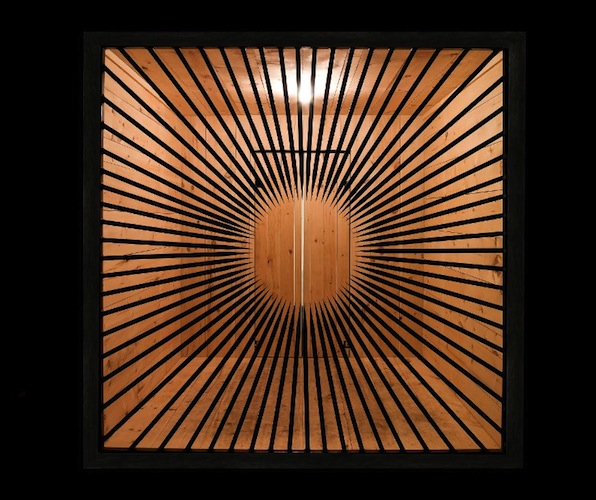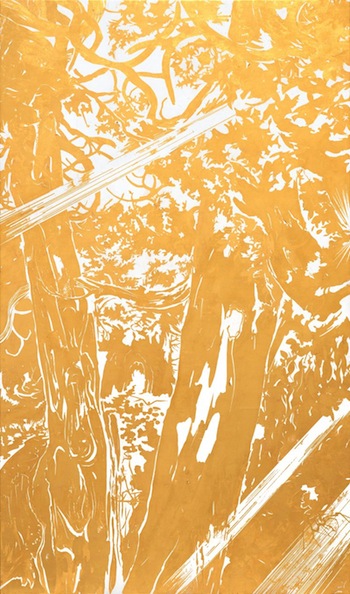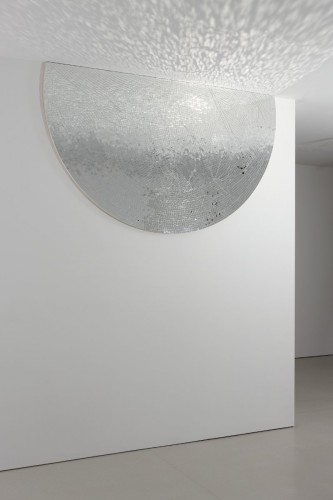Visual Arts Review: Jim Hodges — Applying Sentiment to Post-Minimalism
This exhibition pits Jim Hodges’ undoubtable sincerity against the stylistic requirements of post-minimalism in battles that often come to a draw.
Jim Hodges: Give More Than You Take, at the ICA, Boston, MA, through September 1

Jim Hodges, the dark gate, 2008, wood, steel, electric light, perfume, paint, flooring, © Jim Hodges
By Franklin Einspruch
It was strange hearing Anna Stothart, the ICA’s assistant curator, call Jim Hodges “sentimental” as a compliment. But she did so a few times at the June 3 press preview for Hodges’s career review, “Give More Than You Take.” Sentimentality is a vice in art, but pretense is a worse one, so candor tips the balance favorably in Hodges’s direction. However, all bad poetry springs from genuine feeling, as Oscar Wilde reminds us, and this exhibition pits his undoubtable sincerity against the stylistic requirements of post-minimalism in battles that often come to a draw.
You may think that post-minimalism has no stylistic requirements, but in fact it’s a balancing act between not looking enough like art and looking too much like art, and only a sophisticate can pull it off. Its direct visual ancestor is 1970s conceptual art, cited in spirit as a reaction to the overheated quality of early- and mid-’80 neo-expressionism. It favors the use of non-art materials and a coy attitude that some think of as intellectualism but would be more aptly called bookishness, an exaggerated consciousness of meaning and references. It’s as milquetoast as Julian Schnabel’s plate paintings were macho, intentionally.
The question of how to retrofit sentiment onto conceptual art was thoroughly worked out in the early ’90s by Felix Gonzalez-Torres, a friend of Hodges’s whose specter hangs over this exhibition. In works by Hodges that depict an eagle and a butterfly, such as the freestanding panels of stained glass entitled When I Believed, What I Believed (2008), Hodges is memorializing their friendship. He is the butterfly, and Gonzalez-Torres the eagle.
Gonzalez-Torres’s career was cruelly truncated, but he arrived early at the tree of post-minimalist possibilities and claimed the low-hanging gestures. Everyone working similarly since him has had to struggle up its trunk. This goes even for Oscar Murillo, whose foil-wrapped chocolates at David Zwirner (NYC) this year were likened by more than a few observers to Untitled (A Corner of Baci) by Gonzalez-Torres from 1990, and not favorably.

Jim Hodges, and still this (detail), 2005-08, 23.5k and 24k gold with Beva adhesive on jessoed linen in ten parts. Photo: Brad Flowers, courtesy Dallas Museum of Art, © Jim Hodges
Something similar if not so damning crossed my mind upon seeing Hodges’s He and I, dated to 1998 but recreated afresh for every installation, this one at the ICA included. Two circles, one of the diameter of the artist’s height and one of a former partner’s, are drawn on the wall in blue and pink Prismacolor pencil respectively so as to overlap. The artist and any available collaborators then draw concentric circles inside of each one until filled. According to Hodges’s instructions, the drawing must be done while thinking of love. It takes a week. However touching the result, we’ve been here before, formally and thematically, with Gonzalez-Torres’s “Untitled” (Perfect Lovers) from 1987, Untitled (Double Portrait) from 1991, and several other works. (If he didn’t invent it, he was a leading proponent of the silly Untitled (Title In Parentheses) format for naming works.) The evidence of the human hand in them is helpful to the sentiment, but one wishes that it came off more as an homage and less as a literal recycling.
Maybe it’s a problem in general for artists born in the ’50s to figure out how to escape the ’90s. A cluster of flower drawings in various office-grade pens on aging paper napkins by Hodges dating from 1994 recall Amy Sillman’s scrappy portraits from around the same time that we saw at the ICA late last year. Like Sillman, Hodges shook off the reticent look of the era by going big in a way that Gonzalez-Torres could never muster. (His billboards don’t count. Large-scale creation is not merely a process of enlargement.) Here’s where we will stay from 1995 is a wall of found silk scarves stitched together by the artist. Its gravitas derives from context that wouldn’t be easy for a casual viewer to glean. Hodges learned embroidery from his mother and grandmother. Gonzalez-Torres was sick with AIDS and would die the following year. Here’s where we will stay is pretty, but against a backdrop of the horror that the creative community suffered as HIV ripped through it in the ’90s, it takes on associations of prayer flags and burial shrouds. The maternal inheritance of skills puts Hodges in the role of caretaker, perhaps widow.
Such connections are both the source of strength of Hodges’s work and its limitations. Once you learn that certain works can be deciphered, that the butterfly represents the artist for example, the decoded ones start to deliver the questionable satisfaction of repeated punch lines and the remainder leave you wondering whether you’re on the wrong side of a locked conceptual door. Hodges’s work is visually rich enough to justify muscling through either impression, but it requires it.
This is least the case for his built environments. The work in this exhibition that feels maximally resolved, completely urgent, and minimally dependent on backstory is the dark gate from 2008. Hodges has built a room within a room, the outer one blackened and the inner one lit with a weak bulb. The inner one is constructed from rough planks, and the wall opposite its entrance consists of a ring of frightening spikes that turn the darkness beyond it into an evil sun. The tip of each spike is freshened daily – or rather, poisoned – with a drop of Shalimar perfume. You don’t have to know that it’s his mother’s favorite fragrance to pick up on the feminine scent. If it’s a gate, it’s not one you can easily pass through. The effect is complicated and unnerving as it evokes death and the flimsiness of human efforts to protect itself from the void. It suggests one and perhaps all of possible sexual gates as well, presented as a passageway to doom.
Hodges can handle color and light and likely has to in order to escape the other side of his vision periodically. The heavenly counterpart of the dark gate is and still this (2005-08), ten linen canvases arranged in an arc large enough to walk into, upon which cutouts of gold leaf depict scenes of worldly creation and primeval forest, one turning into the other and back again. There are several works involving cracked and tessellated mirrors that simultaneously evoke religious mosaics and Disco, and sometimes reflect other art in the room in a way that’s preferable to the original.
Of final but important note, Hodges can draw, tenaciously if not masterfully. This is evinced in a 21-part series of Burchfieldian abstractions entitled on the way between places (2009), drawn in charcoal on paper using his saliva as a blending medium. They possess an uncertainty that’s refreshing given the tooled quality of a lot of the rest of the art. Also they confirm the existence of a search going on behind the work that requires assistants and fabricators, to its credit. Anyone working in this wide a range of materials and methods is not going to produce masterpieces every time, but evidence of a search makes the misses more forgivable.
“Give More Than You Take” is a good motto for an artist, but a bad one for a viewer. Post-minimalism is largely a demand to put that the other way around, to oblige the viewer to pan for nuggets of gratification in its cold river. Hodges is a better artist than that, though, and like the better artists of any genre he often escapes its constraints.
Franklin Einspruch‘s work spans a wide range of traditional and digital media. While maintaining a studio practice as a painter, he is active in art criticism and comics, and has long experience in Web-based publishing. His seventeenth solo exhibition will take place at Ohio State University, Lima in Februrary 2014. He has completed artist residencies at the Aegean Center for the Fine Arts (Paros, GR), Stock 20 (Taichung, TW), the Heliker-LaHotan Foundation (Cranberry Isles, ME), and the Morris Graves Foundation (Loleta, CA). He contributes regularly to Art in America and the New Criterion, and produces one of the longest-running blogs about visual art, Artblog.net. He publishes under the imprint New Modern Press, whose first title is Comics as Poetry.
Tagged: Give More Than You Take, Institute of Contemporary Art/Boston

